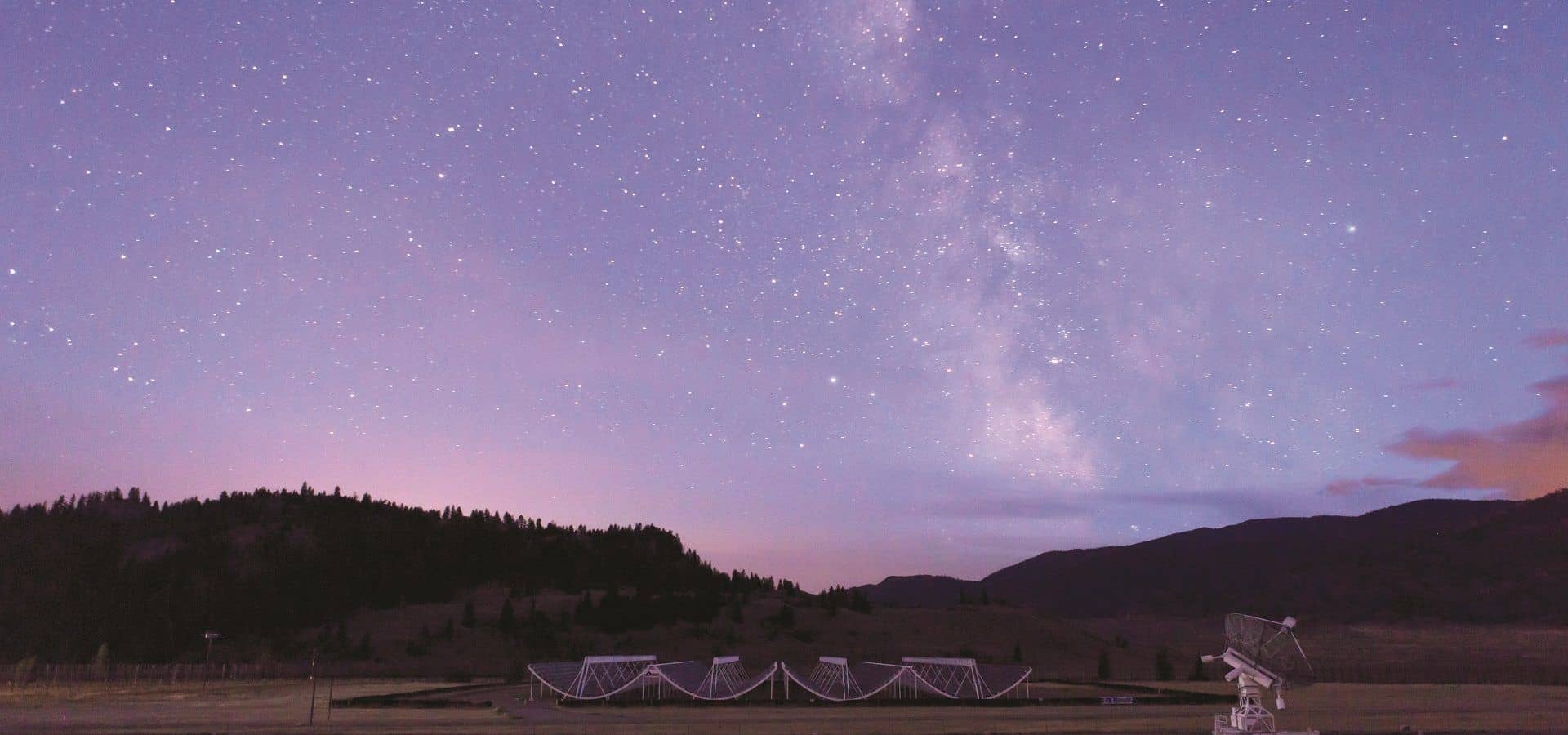Canadian telescope to chime in on evolution of the universe
Perimeter researcher Kendrick Smith is part of a cross-Canada team that will get an unprecedented glimpse at a hidden epoch of the universe thanks to the new CHIME telescope.
Take a self-guided tour from quantum to cosmos!
Perimeter researcher Kendrick Smith is part of a cross-Canada team that will get an unprecedented glimpse at a hidden epoch of the universe thanks to the new CHIME telescope.

From a distance, it looks like a snowboarder’s dream: four halfpipes, each 100 metres long, running side by side amid the Canadian Rockies.
A closer look, however, reveals a structure designed not to propel athletes into the air, but to propel science into uncharted places – or, more specifically, uncharted times – in the universe.
Just outside of Penticton, BC, nestled in a valley protected from radio wave disruption, lies the framework of the CHIME telescope, which will soon begin scanning the sky in search of clues about the evolution of the cosmos.
The CHIME acronym stands for the Canadian Hydrogen Intensity Mapping Experiment, which explains much about what the telescope is looking for, but less about when. CHIME will gaze at the adolescent universe, the middle period when
the personality of the cosmos was, like that of any typical teenager, a bit mysterious.
Whereas the newborn universe of 14 billion years ago is quite well understood (thanks to the cosmic microwave background imprinted on the sky shortly after the big bang), and the more recent universe is within the reach of many experiments, the adolescent universe has remained hidden from view.

“The in-between period is actually very difficult to access,” says Perimeter Institute cosmologist Kendrick Smith, who is working on the CHIME project alongside researchers from the University of British Columbia, the University of Toronto, McGill University, and the Dominion Radio Astrophysical Observatory.
Probing this in-between era of the universe – roughly a few billion to 10 billion years after the big bang – has the potential to uncover important clues about one of the most puzzling problems in cosmology: the acceleration of the universe.
This acceleration, which slowed right after the big bang, picked up speed again during the adolescent era, when the effects of dark energy seem to have begun taking hold. By measuring the distribution of neutral hydrogen in distant galaxies (a technique called intensity mapping), CHIME may glimpse the period in cosmic history when this speed-up occurred, allowing researchers to sleuth out some fundamental answers about why our universe is the way it is.
“At the end of a long chain of steps, we’re trying to answer some really fundamental mysteries of physics,” says Smith. “How did the big bang happen? What is the particle identity of dark matter? What new physics is responsible for the late-time acceleration of our universe?”
Until very recently, an experiment with the ambitions of CHIME would have been impossible because the technological horsepower needed to process the data it will collect simply did not exist. That horsepower has come from a somewhat unexpected source: the video game industry. It turns out that the kind of co-processors required to blast marauding aliens on next-generation gaming consoles can, with minor tweaks, process the vast amounts of data that CHIME will collect when it becomes fully operational in the next couple of years.
“We’ve been waiting to get more powerful computers for a long time,” says Smith. “It’s such a big computing problem to analyze all the data.”
When CHIME begins scanning the sky, it will process information in real time at a rate of approximately one terabit per second. That’s roughly one percent of the processing requirements of the entire Internet – a staggering, unrelenting surge of information.
That’s where Smith comes in. He describes himself as a “dataoriented cosmologist,” and has made significant contributions to the collection and analysis of enormous data sets on the Planck Satellite and Wilkinson Microwave Anisotropy Probe (WMAP) projects to map the cosmic microwave background.
Smith and colleagues, including Perimeter Associate Faculty member Ue-Li Pen, will face a number of new challenges when it comes time to analyze the data streaming into CHIME – partly because of the sheer vastness of time and space the telescope will probe.
The telescope’s unconventional design – the four side-by-side halfpipes – makes it particularly suited to such an ambitious project. While the telescope itself has no moving parts, it happens to be affixed to a very reliable piece of moving machinery: planet Earth. Every night, the rotation of our planet will sweep CHIME’s curved, wire-mesh surface across a new swath of the cosmos, allowing it to pick up faint radio emissions from our universe’s distant past.
Night after night, month after month, CHIME will amass enough information to map cosmic structure over the largest volume of the universe ever observed, with resolution sharp enough to discern ‘baryon acoustic oscillations,’ which are fluctuations in the density of matter in the universe that help cosmologists understand more about the effect that dark matter has on the accelerating universe.
Smith, with collaborators across Canada, will scour the data in search of the elusive catalyst that sparked the universe’s accelerating expansion. For now, they must wait until CHIME’s halfpipe reflectors are outfitted with the high-powered electronics that will complete its eye on the sky.
“It’s a very exciting project,” says Smith. “The most exciting thing would be if we measure the expansion history of the universe better than anyone else has – that we learn something really new and fundamental. But we don’t really know where it will lead, and that’s part of the fun.”
A round-up of the latest news from Perimeter, a look at the recent work of researchers and alumni, gems from the archive, and fun physics for everyone
The CHIME/FRB Collaboration reveals a new type of fast radio burst with pulses spaced milliseconds apart in a new paper released today in Nature.
A round-up of what’s up: the latest news from Perimeter, a look at the recent work of researchers and alumni, gems from the archive, and fun physics for everyone.